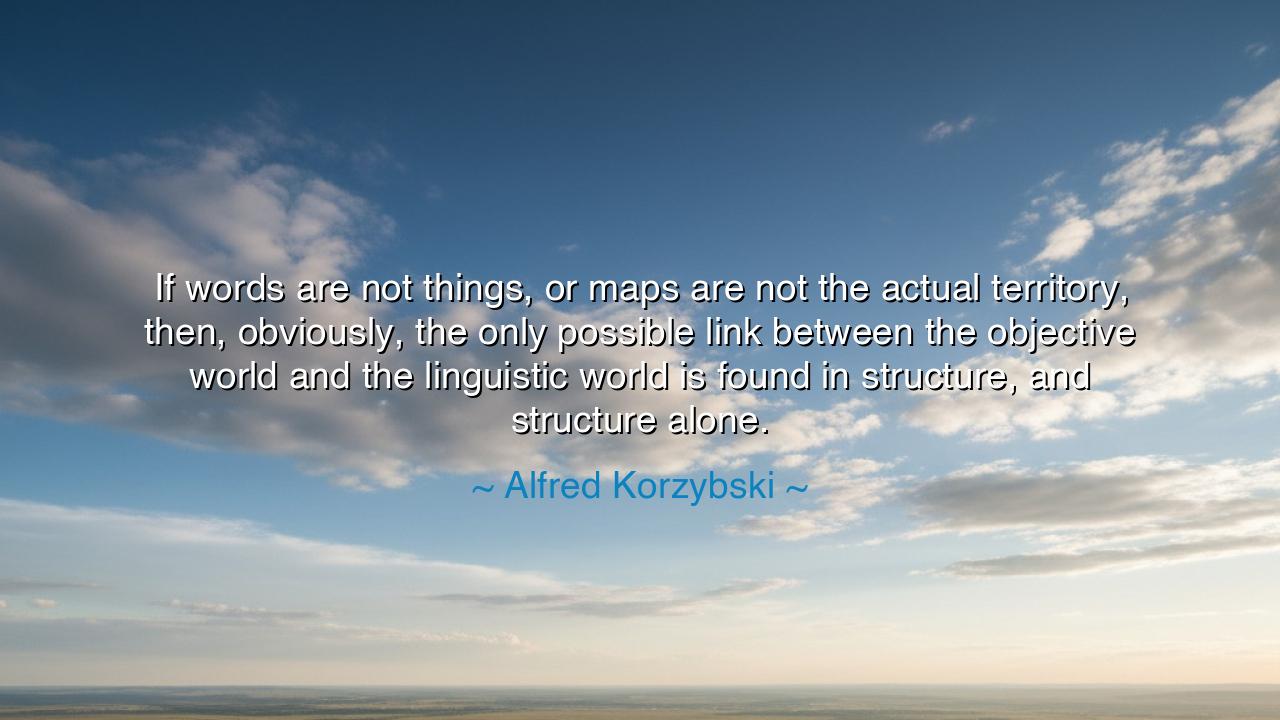
If words are not things, or maps are not the actual territory
If words are not things, or maps are not the actual territory, then, obviously, the only possible link between the objective world and the linguistic world is found in structure, and structure alone.






“If words are not things, or maps are not the actual territory, then, obviously, the only possible link between the objective world and the linguistic world is found in structure, and structure alone.” — so wrote Alfred Korzybski, the philosopher and scientist who sought to remind mankind that language is not reality, but a reflection, a pattern of signs meant to guide our understanding of the world. In these words, Korzybski calls upon us to awaken from illusion — to remember that words, though powerful, are but maps, and maps, however detailed, are not the land they describe. The truth of existence lies beyond the boundaries of speech, yet it is through the structure of our language — the order and pattern of meaning — that we may hope to approach it.
The origin of this profound insight lies in Korzybski’s philosophy of General Semantics, a discipline born in the early twentieth century, when science, psychology, and communication were undergoing rapid transformation. In his book Science and Sanity (1933), Korzybski observed that human beings often mistake their symbols for the realities they represent. Nations go to war over words, faiths fracture over names, and individuals suffer because they cannot separate the map — the abstraction of language — from the territory, the living truth of experience. His teaching was not a rejection of language, but a call to use it wisely, humbly, and with awareness of its limits.
To understand his meaning, we must first grasp his metaphor. The map is a tool; it shows us paths, boundaries, and destinations, but it is not the landscape itself. A man may study a map of mountains, yet know nothing of their cold air or rugged peaks. So too, a man may speak eloquently of love, justice, or peace, yet never live them. Words are symbols, not substance — they are the structure through which we represent the world, not the world itself. Korzybski warns us: when we confuse the two, we lose touch with reality. We begin to live in abstractions, mistaking opinion for fact, and description for truth.
Consider the tragedy of Galileo Galilei, who looked through his telescope and saw the moons of Jupiter circling a distant planet. To him, it was clear: the Earth was not the center of all things. Yet his discovery clashed with the linguistic structures of his age — the doctrines and dogmas built not upon observation, but upon inherited words. The Church, clinging to its maps, condemned him, for it could not yet see the territory. Galileo’s ordeal reveals Korzybski’s wisdom: that language, when divorced from structure grounded in reality, becomes a prison rather than a guide. Only when words align with the structure of truth can knowledge advance.
Korzybski’s teaching extends far beyond science. It reaches into the soul of human understanding. In our own lives, how often do we mistake words for the things they name? We say “love” and think the word is the feeling. We say “freedom” and think it is the law. We say “good” and think it is the same for all. But words, though sacred, are shadows cast by the light of reality. Their power lies in their structure, their relationship to one another and to the truths they attempt to capture. When used rightly, they guide the mind; when worshiped blindly, they lead it astray.
This truth is seen again and again in history. The Tower of Babel, built of words and ambition, crumbled when human beings mistook communication for communion. They spoke, but they no longer understood. Likewise, every age has its Babel — times when humanity builds vast systems of language, ideology, and creed, forgetting that the world itself is greater than any symbol we give it. Korzybski’s wisdom is a warning and an invitation: to speak with care, to listen with humility, and to remember that our words are not the world — they are bridges to it.
The lesson, then, is one of mindfulness and discernment. When you speak, remember that your words are maps, and that every listener carries their own terrain. Seek to align your speech with truth, not merely with comfort. When you read or hear the words of others, do not take them as final; test them against the structure of your experience, the evidence of your senses, and the clarity of reason. Learn to look beyond the name to the thing named, beyond the description to the reality it reflects. For it is in this alignment — between language and life, between structure and truth — that wisdom is born.
So let Alfred Korzybski’s words guide you like a compass in a world of signs: “Words are not things, maps are not the territory.” Speak not to dominate, but to illuminate. Listen not for noise, but for meaning. Build your maps carefully, but never mistake them for the mountains they depict. For though the path may be drawn in ink, it is only by walking upon the earth — feeling its stones, breathing its air, hearing its silence — that one truly knows the world. And in that knowing, the structure of language finds its purpose: not to replace reality, but to lead us humbly toward it.






AAdministratorAdministrator
Welcome, honored guests. Please leave a comment, we will respond soon